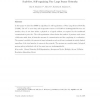129 search results - page 3 / 26 » Scale-free, self-organizing very large sensor networks |
GECCO
2005
Springer
14 years 3 months ago
2005
Springer
This article describes a mathematical framework for characterizing cooperativity in complex systems subject to evolutionary pressures. This framework uses three foundational compo...
JPDC
2010
13 years 8 months ago
2010
ICCCN
2007
IEEE
14 years 4 months ago
2007
IEEE
— Autonomous localization of nodes in wireless sensor networks is essential to minimize the complex self organization task and consequently enhancing the overall network lifetime...
IDEAL
2005
Springer
14 years 3 months ago
2005
Springer
The neural representation of space in rats has inspired many navigation systems for robots. In particular, Self-Organizing (Feature) Maps (SOM) are often used to give a sense of lo...
IOR
2011
13 years 4 months ago
2011
This paper introduces and studies the maximum k-plex problem, which arises in social network analysis and has wider applicability in several important areas employing graph-based ...

